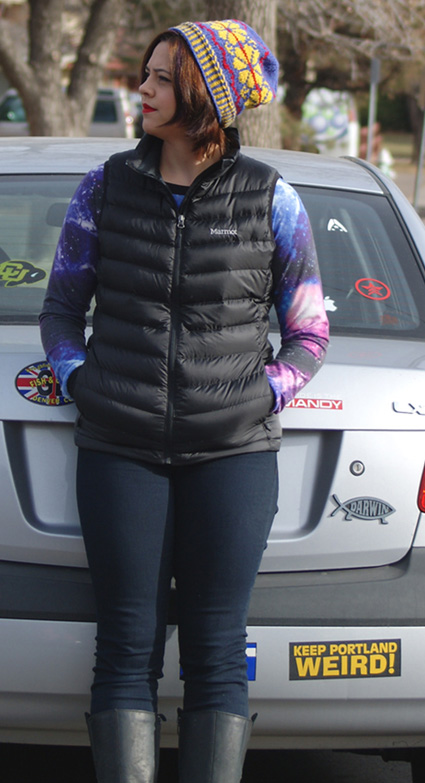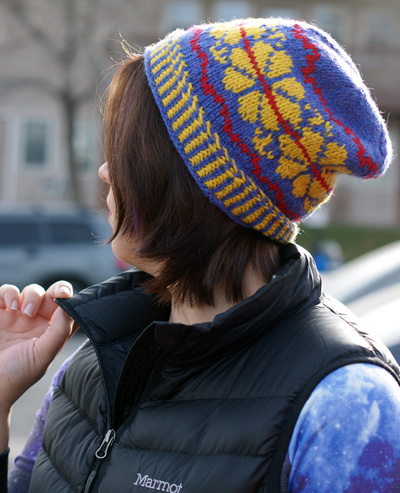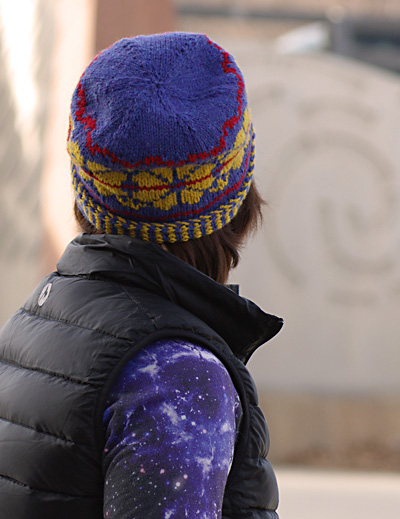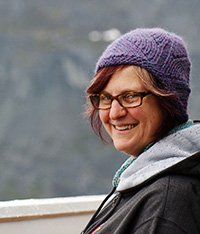

|
|
|
|
What's your favorite knitting tradition from around the world? If you're like me, you have a hard time choosing. A few of my favorites are cable knits from the Aran Islands in Ireland, toe-up socks from Turkey, lace shawls from Estonia, complex pattern stitches from Japan, and elaborate colorwork hats from Peru. Everywhere that people adopt knitting, they put their own spin on it and invent techniques to incorporate their unique design sensibilities in pattern, texture, and color. When you celebrate these knitting traditions, you also celebrate the people who invented them, as well as those who carry on the traditions and continue to make these objects today. *** Several weeks after this essay was due, I found myself rewriting it from scratch. I had written a nice little piece about the joys of celebrating knitting traditions from around the world, with a special focus on the contributions of indigenous peoples of the far north-- the Oomingmak knitters in Alaska and the Saami in Sweden and Finland. But as I (belatedly) put the final touches on my column, I found myself reading a blog post by knitting designer and friend, Karie Westermann, who was recently harassed while riding a bus when a "nice lady" sitting beside her decided to tell everyone on the bus why immigrants -- a group that included my friend, unbeknownst to her seatmate -- were lazy, stupid, low-lifes who were ruining her country. This new essay is, like the original one that I wrote, about knitting. It is even still about the variety and value of knitting traditions. However because of my friend's experience, it now also needs to include not just the joys but also a much darker topic. It now needs to encompass something that, when I was a kid in the 1970s, we called "prejudice." Prejudice was a bad thing, and everybody knew that it was bad. If you were prejudiced (and if we're honest, we all are, at least in some small ways), you tried to hide it and you tried to improve yourself by overcoming your fears of people who were different than you. Growing up, I believed that prejudice was something previous generations were guilty of, and that it was fading away into the past. My generation was overcoming it. We were making the world a better place by accepting each other, no matter where we came from, what we looked like, what religion we practiced, or what language we spoke at home. In the early '90s, I was shocked out of my little dream world when one of my closest friends asked me, "Can you believe Jane kissed a ---?" I still loved her and enjoyed her company -- I don't have to agree with much of anything that my friends believe -- but I felt that if I continued to be her friend, I was tacitly condoning her prejudice. Maybe I was wrong to do so, but I walked away. (Sometimes now I put down books by knitting authors who proclaim that there is one right way to hold your yarn and needles, or one best way to work a purl stitch.) Sadly, it seems that prejudice has come out of the closet over the decades since I was a girl, and has become acceptable, even honorable, in some circles. I didn't think I'd have to be worried about this in the twenty-first century. But here I am, witnessing a rise in prejudice around the world. Today it's called by many different names: xenophobia, racism, anti-immigration, sexism, homophobia, ethnic pride. But all of these things grow from the same diseased root: prejudice. Knitting, I believe, can be a cure. When you knit something with a technique or pattern motif from Sweden, Japan, Russia, Peru, Mexico, or Nigeria, remember that there are real people in these places, as well as real people from these places who probably live somewhere near you, who are responsible for inventing the techniques and creating the designs you love. Did you know that the toe-up sock -- and maybe even knitting itself -- was invented by Arab knitters? Did you know that the colorwork motifs knit in Fair Isle patterns may have been inspired by knitters in Lithuania or Latvia? Did you know that "English" and "Continental" are not the only two ways to knit? Did you know that the ways we hold our yarn and needles can tell us something about our family history and our ethnic background, if we were lucky enough to have learned to knit from our mother, grandmother, or favorite aunt? The way I knit links my heritage to Eastern Europe, with an idiosyncrasy that seems to be specific to Ashkenazi Jews. I used to be prejudiced against other knitters' styles. My grandmother was, after all, the world's best knitter, and she did everything the best way possible. The people who wrote knitting books expressing other ideas were just ignorant, as was my friend who wasted so much time letting go of the needles before forming each stitch while she wrapped the yarn around. Obviously she was doing something wrong -- her stitches were backwards! Over the years, I've learned that there are many different ways to knit. I've been working on overcoming my knitting prejudices. My friend wasn't making stitches that were backwards. She was making stitches that were different than mine. In the end, her knitting came out right, and so did mine. I've also been working on overcoming my human prejudices. Do I struggle to accept certain groups of people without preconceived notions because of where they come from? Do I find myself reluctant to even try some knitting techniques? When I walk down a dark alley in a city, am I more afraid of men dressed a certain way, who wear a certain style of clothing, who have a certain kind of hair style or a certain skin complexion? Of course these questions plague me. But I am still working to overcome my prejudices. I am not accepting or embracing them. I know they are not rational, and that I can be a better person by not giving in to these fears, wherever they come from. In that spirit of joy with which I began this journey, please enjoy this month's pattern, created by my friend, talented designer Susan Santos. |
|

While in Stockholm we spent an afternoon in the Nordiska museet -- the Nordic Museum. Fabulous, especially for hardcore knitters! There were wonderful exhibitions of Swedish folk art, fashion, and the Saami (or Sami), the arctic indigenous people of northern Sweden, Norway, Finland, and Russian. Summers are brief in this part of the world and winters are long, dark and cold. I imagine when your language has about 300 different ways of describing snow, you need as much color in your life as you can get. Traditional Saami folk costumes are often trimmed with colorful woven bands of zigzag lines, and decorated with flower-shaped jewelry. I designed this hat to reflect some of the design elements of those bands, but in the slouchy shape that's hot right now. |
|||
SIZE |
|
Notions GAUGE |
PATTERN NOTES CDD (centered double decrease): Slip two stitches together as if to knit. Knit one. Pass the slipped stitches over the knitted stitch. |
|
DIRECTIONS |
 Using small circular needle and MC, with the Twisted German method, CO 96 sts. Place marker and join for working in the round, being careful not to twist. Join CC 1. Rnd 1: [K1 MC, k1 CC1] around. Rnd 2: [K1 MC, p1 CC1] around. Repeat Rnd 2 until cuff measures 1.5 ins from cast on edge. Latvian Braid Setup rnd: [K1 MC, k1 CC1 around. Braid rnd 1: Bring both yarns to the front. [P1 MC, p1 CC1] around, always bringing the new color from under the old color. This will twist the yarns. Don't worry. The next rnd will untwist them. Braid rnd 2: [P1 MC, p1 CC1] around, always bringing the new color from over the old color. This will untwist the yarns.  With MC, knit 3 rnds. Change to larger 16-inch circular needle. Next round: Work Flowers chart around. Work as set until chart is complete. Cut CC1 and CC2. Change to smaller 16-inch circular needle. Crown Rnd 1: [K16, pm] 6 times around. Repeat Rnds 2-3 6 more times, until 12 sts rem. Final round: CDD 4 times. 4 sts rem. Block and weave in ends. |
| ABOUT THE DESIGNERS |
 Visit Donna's website at sheeptoshawl.com. |
|
|
| Pattern & images © 2014 Donna Druchunas + Susan Santos. All rights reserved. Contact Donna |